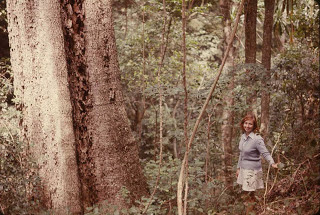Adults that don't jump to a permanent body of water die in the dry season, but the eggs survive in the dried mud, hatch the next rainy season, and mature quickly to breed.
Thus killies can be kept in small covered tanks, but need clean water, safety, and a tight fitting lid.
To breed them we separate the sexes into side-by side tanks, so they can see their mate. We feed them heavily with live foods for 2-5 days. After the females fill with eggs we place pairs in 2 1/2 gallon breeding tanks with an airstone and a nylon mop with a cork for floatation. Again, the water is about 2/3rds full, and has a very tight fitting lid. You can expect more than 10 eggs a day, and most will be fertile. When the female's belly flattens or she has bite marks on her fins, remove her immediately.We put her back in her isolation tank which is heavily planted.
In the watercolor above, the male A. Epiplatys dageti chases the female. Note her ragged tail fin.
Label a dish and lid to receive the eggs and take the mop out. Let the excess water drain, don't squeeze it.
Dad is past retirement age and needs strong reading glasses, left, to see the eggs. These may be purchased for a few dollars at Walmart. They are strength 1.5 or 1.75 magnifiers, whatever they have.
The mop is synthetic "Acrylic" or Nylon yarn wrapped around a book. The book is the size of the depth of the water, plus one inch. Once you have enough wraps, then tie the strands at one end, cut at the other, and finally tie the mop to a cork with a groove cut around the center. We label cork with the species name to identify the mop.
Gently survey the surface of the mop and then systematically search the interior for eggs.
Above an A. Epiplatys dageti egg is near the curved tip of the eyedropper
Gently pick the egg up with very clean fingers, with no soap or anything else on them.
Then drop it in the water. I use aged aquarium water in petri dishes with partitions. Some add a little Methylene Blue or Salt to discourage fungus.
Here is a video of the process. I make these videos for my sons who help raise the fish,
Lighted for photo. Normally this area is DARK
We place the eggs in labeled covered petri dishes on a dark shelf. The
camera flash makes the shelves seem bright, but usually they are in the shade.
Toothpicks hold the upper lid open a little for air. When the embryos darken you can see the fish in the egg with a magnifying glass; at that point the ripe eggs are trasfered to 1" of water in pyrex bowls
Once they hatch we place them in a clean tank (above left) and add infusoria,
then newly hatched brine shrimp when they seem large enough (right). Notice that the water is left shallow for the smallest fry on the left.
For brine shrimp put 3 Tablespoons of Sea Salt per gallon of water, then add about 1/2 teaspoon of brine shrimp "eggs". We do this in the center jug, which sits on a rubber terrarium heating pad. After 24 hours transfer the mix of nauplii and shells to the inverted bottle, with its bottom cut off. We place it in a coffee pot to hold it, as shown. You can also use a 2 liter soda bottle; Cut off the base, put the shrimp in the inverted top, use the cut off base as a stand.
To collect the newly hatched shrimp remove the aeration and shine a light on the neck. In ours we covered all but the neck with tape. The brine shrimp naplii are attracted to the light at the neck of the inverted bottle, the only part not darkened by tape. A turkey baster removes the shrimp, and these are squirted into a very fine "brine shrimp net", then dipped into fresh tank water and fed.
As the babies grow raise the water level (tight lid!) and add fine powdered dried food and vinegar eels.
At 1/2 inch of length, transfer them to a 10 gallon tank for growing out, about 10 fish to a tank.
When they can be sexed, match individuals with the opposite gender, making up pairs who are not sibings . This avoids inbreeding. This tank pictured above contains 8 Aphyosemion primigenium, our conservation project.
Here is a watercolor of the A. primigenium male.





















